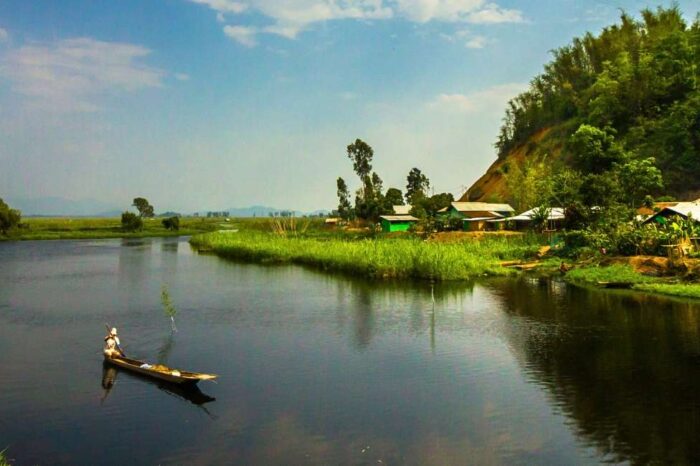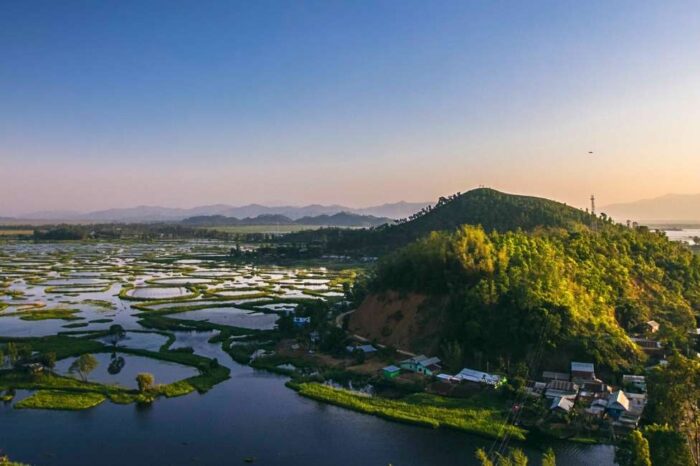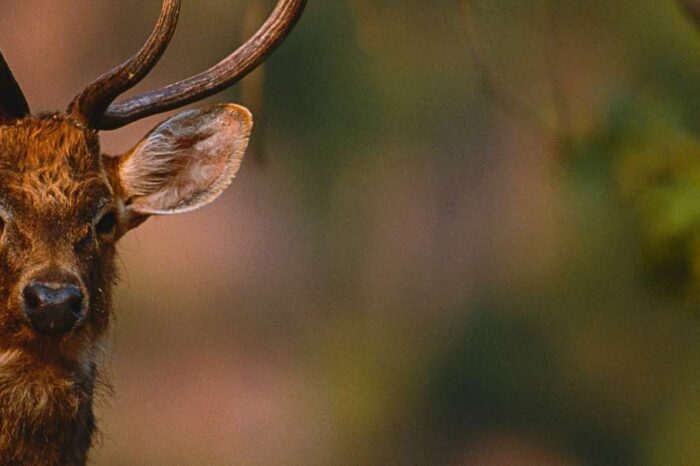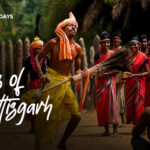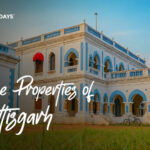- Home
- INDIA
- Offbeat India
- International
- Theme Tours
- Blogs
- Case Studies
- Plan Your Trip
Manipur
Manipur: The Crown Jewel of India Nestled in the easternmost corner of Northeast India lies a dazzling gem – Manipur. Oval-shaped, vibrant green, and brimming with things to do, see, and experience, Manipur remains largely untouched and undiscovered by the […]
Manipur: The Crown Jewel of India
Nestled in the easternmost corner of Northeast India lies a dazzling gem – Manipur. Oval-shaped, vibrant green, and brimming with things to do, see, and experience, Manipur remains largely untouched and undiscovered by the world outside. From its culture and cuisine to its stunning landscapes, it retains an unspoiled charm. Surrounded by rolling hills and adorned with sparkling lakes and lush forests, it’s no surprise that Manipur translates to “the land of gems.”
Manipur: A Quick Overview
- Capital: Imphal
- Official Language: Manipuri Meiteilon
- Dial Code: 0385
- Population: 2.267 million (as of 2018)
- Currency: Indian Rupee (INR)
- Time Zone: UTC+05:30 (IST)
- Area: 22,327 square kilometers
Highlights of Manipur
Imphal
Imphal, with its untouched beauty, is steeped in history and culture. Explore the site of the historic World War II battle and visit Kangla Fort, where ancient palaces, pilgrimage sites, and the sacred Nungjeng Pukhri pond tell tales of a rich past. The Manipur State Museum offers further immersion into the state’s cultural heritage, featuring fascinating exhibits, including the 54-foot-long traditional boat, Hiyag Hiren.
Wildlife
Manipur’s hills are alive with an incredible variety of wildlife. The state is home to rare species like the endangered Brow Antlered Deer, Stump-Tailed Macaque, Clouded Leopard, and an astonishing array of over 500 orchid varieties. Nature lovers and wildlife enthusiasts will find themselves captivated by the state’s rich biodiversity.
Pilgrimage
Manipur is a beautiful mosaic of spiritual beliefs, where Hinduism, Christianity, and Islam coexist harmoniously. Visit the ISKCON Temple and the Shree Shree Govindajee Temple to experience the state’s vibrant spiritual life. Babupara Mosque serves as an important place of worship for the Muslim community, while the Phungyo Baptist Church, built in 1901, stands as the first church in Manipur, offering a glimpse into the state’s deep-rooted spiritual history.
Loktak Lake
Serene, blue, and utterly mesmerizing, Loktak Lake is the largest freshwater lake in the Northeast. The lake’s unique feature is its phumdis—floating masses of organic matter that create natural islands. One of these phumdis spans a staggering 40 square kilometers and houses the Keibul Lamjao National Park, the only floating national park in the world.
Culture
Manipur’s cultural fabric is woven with the threads of Meitei traditions, the Kukis, Nagas, Manipuri Brahmins, and Pangal (Manipuri Muslims). The state is known for its colorful fairs, festivals, and rich traditions. Cheiraoba, the Manipuri New Year, is the most famous festival, celebrated with great zeal. For an immersive cultural experience, catch a performance of Jagoi, the classical Manipuri dance, or visit the Chorus Repertory Theatre, which showcases plays depicting Manipuri stories and lives.
Cuisine
Manipuri cuisine is a delightful blend of flavors, known for its spicy taste, achieved by using chili peppers instead of garam masala. Savor dishes like Eromba, a spicy chutney of boiled vegetables and red chilies; Singju, a salad of banana stem, banana flower, cabbage, lotus stem, herbs, and seasonal vegetables; and Chamthong, a hearty stew made with vegetables, fish, and rice.
Interesting Facts About Manipur
- Birthplace of Polo: The game of polo originated in Manipur, later popularized in Western countries by the British.
- Floating National Park: Manipur is home to Keibul Lamjao National Park, the only floating national park in the world.
- Ima Keithel: Asia’s largest all-women market, Ima Keithel, is in Manipur, boasting 500 years of history and around 4,000 women traders.
- Ancient Inhabitation: Evidence shows that Manipur has been inhabited since 30,000 BC, with life chronicled in the Khangkhui Caves.
- Bamboo Diversity: Manipur produces over 1 million tonnes of bamboo annually, with 52 of the world’s 125 bamboo species found here.
- Irom Sharmila: The famous civil rights activist, known as the “Iron Lady,” hails from Manipur. She carried out one of the longest hunger strikes in history, lasting over 500 weeks.
Location: Gateway to Greatness
Manipur shares its borders with Nagaland to the north, Mizoram to the south, and Assam to the west. It is known as the Gateway to the East due to its eastern border with Myanmar. The town of Moreh serves as the crucial trade link between India, Myanmar, and other Southeast Asian countries.
Best Time to Visit
Winter (October to March) is the best time to visit Manipur, as the state experiences cool, pleasant weather, with temperatures dropping to around 8°C at night. Daytime brings mild sunshine, making it perfect for outdoor exploration. While summers are warm and humid, the temperatures remain bearable. The monsoon season, with its lush greenery and moderate rainfall, paints the state in vibrant hues.
Getting to Manipur: Way to the Valley
- By Road: Travel to Manipur via NH2 from Nagaland, which connects Kohima to Imphal, or take the road from Silchar in Assam. State tourist buses from neighboring regions like Aizwal, Itanagar, Kohima, Dimapur, and Shillong make road travel convenient.
- By Rail: Though Imphal does not have its own railway station, the closest one is Dimapur in Nagaland. From there, daily buses ply to Manipur via National Highway 39, covering a distance of about 215 kilometers.
- By Air: Imphal Airport, around 8 kilometers from the main city, is well connected to major cities like Delhi, Guwahati, and Kolkata. Major airlines operate here, and private taxis are available outside the airport for onward journeys.
History: Millennia of Monarchy
Manipur’s history is deeply etched in its ancient Puyas or Puwaris—sacred texts that record the lives of the indigenous Meitei people. With over 108 kings recorded in its 3,500-year history, Manipur has gone by many names, including Tilli-Koktong, Poirei-Lam, and Meitrabak. Its capital, once known as Kangla and Yumphal, is today called Imphal.
In 1891 AD, the sovereignty of Manipur was lost to the British after the Anglo-Manipuri War of Khongjom. It then became part of British Burma until 1947. On August 14, 1947, Manipur regained its freedom, and on October 15, 1949, it officially unified with India.
Embark on Your Manipur Journey with Ocean6 Holidays
Explore the enchanting landscapes, rich history, and vibrant culture of Manipur with Ocean6 Holidays. From the serene Loktak Lake to the bustling streets of Ima Keithel, every corner of this magnificent state awaits your discovery. Let us craft a journey filled with authentic experiences, historical marvels, and cultural delights that reflect the true essence of “The Land of Gems.”
Experiences
- Chanderi SilkNovember 28, 2025
- Waterfalls of ChhattisgarhOctober 29, 2025
- Tribals of ChhattisgarhAugust 12, 2025
- Jewellery and Handicrafts of ChhattisgarhAugust 12, 2025
- Heritage Properties of ChhattisgarhAugust 12, 2025
- Chanderi Silk
Call
98742 84569
98743 61951
Mon-Sat 11.00AM-07.30PMNewsletter
Rate & Review Us
Contact Info
- +91 98742 84569
- experience@ocean6.in
- 16, Suren Tagore Rd, Ekdalia, Ballygunge, Kolkata, West Bengal 700019
- Mon - Sat : 11.00 AM - 7.30 PM
Sunday : CLOSED
Newsletter
Quick Links
